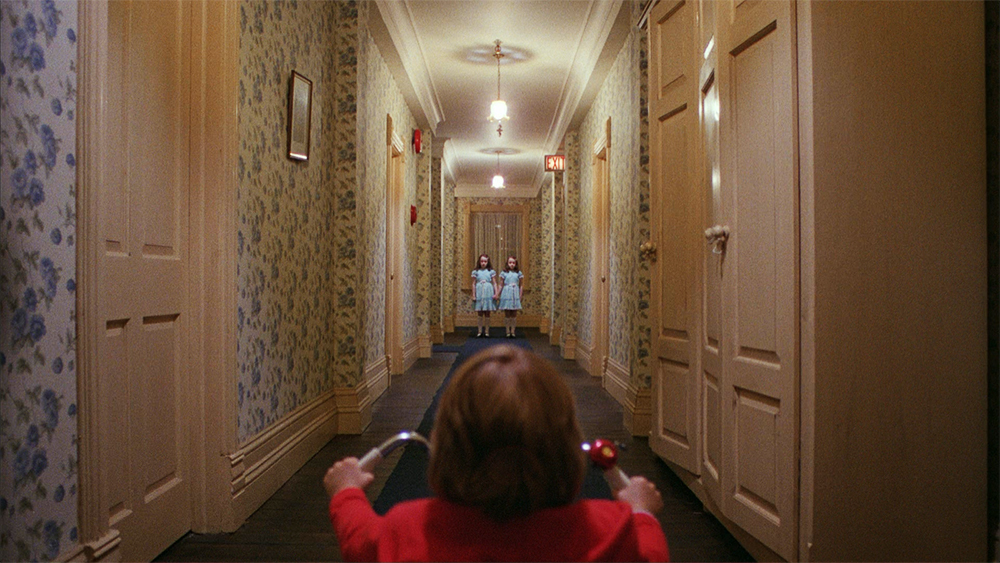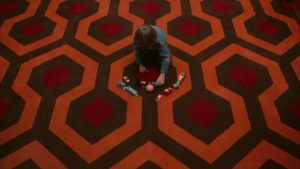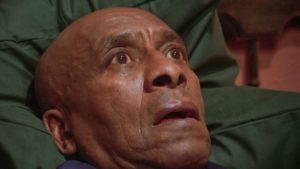
Dizzying aerial views soar over rolling hills of the Colorado rockies following a yellow punch buggy which navigates ascending roads. A low register of disturbingly haunting music draws us into the grandiose atmosphere on screen, and we wonder: Who is driving? What terror in the air may descend upon them as they reach their destination? What will be their almost certain demise?
The Shining does not waste any time: its opening plunges the audience straight into a deep end of dread and suspense which grows robust as the strange story unfolds.
After these intro credits, we meet our main character, Jack Torrance, who strides into the populated lobby of the Overlook Hotel. A transplanted writer from Vermont living in Denver, Jack has applied to be the winter caretaker of the enormous hotel. His wife and son wait down in the city to hear if they will relocate to the Overlook come October.
The camera stalks Jack as he walks into the office of general manager Stuart Ullman, where they discuss the particulars of the position. The meeting is productive despite a confession from Ullman about a murder/suicide having taken place at the hotel. Jack doesn’t seem to mind this incident, and presents himself as upbeat about taking on the position of caretaker for the long stretch of winter. He places high importance on a writing project he is outlining, saying “5 months of peace is just what I want.”
Wendy, Jack’s wife, receives a call from him after the interview where Jack tells her that he has committed to the job, though he neglects to mention the murders. Wendy is happy to hear of the success and is encouraging while Jack, now out of Ullman’s office, has lost his upbeat disposition and become curt instead.
In these opening scenes, as well as in most of the film, the camera sits a reasonably far distance from the actors, either at a medium or wide shot. This creates an imposing sense of the smallness for the characters in their environment. With the enormity of the hotel and the grounds, as well as the picturesque and hard to ignore background of the mountains, the characters are dwarfed by the grandeur of the space.
The negative space in the frame, used throughout the film, draws attention to the characters’ lack of grounding or place. They are nearly lost in the architecture of the hotel, and even in the patterns on screen. This is not only apparent to us, but to the characters themselves, causing them anxiety and confusion, for which they have varied responses.
Jack offers a fight response. He becomes severely unhinged after a month at the Overlook and succumbs to the allure of the metaphysical powers of the hotel; descending into a mirage of the hotel of the 1920s where he has the clout and authority he believes he deserves.
Wendy tries to hold onto the aim of being a helpful mother and wife, but she grows certifiably terrified of the situation she has found herself in at the hotel, which leads her to weakly fighting against her deranged husband to save her child and herself.
Wendy becomes weepy and desperate as the film progresses, which perhaps was not an act. By the end, she runs around the hotel, loftily waving a knife in the air, looking for her son who is being chased by her axe wielding husband.
Danny, a curious and quiet child, does not have trouble playing alone, especially as he is accompanied by an omniscient imaginary friend who lives “in his mouth,” named Tony. Danny, through Tony, has the power to see flashes of the past, and possibilities of the future, and to communicate telepathically with select people and places. Dick Halloran, the chef of the Overlook Hotel played by actor and musician Scatman Crothers, explains to Danny that this these powers are called “shining.”
After about a month up in the hills, when Danny has seen enough of the secrets and malevolence of the hotel, he communicates with Dick Halloran to try to get assistance. Jack realizes Danny has shined a distress call, and then goes after Wendy and Danny to try to extinguish them before help can arrive.
“This whole place is such an enormous maze, I feel like I should leave a trail of breadcrumbs every time I come in.” Wendy jokes early in the film while walking through the kitchen with Dick Halloran and Danny. This turns out to be sage advise for all of the characters, and in the conclusion of the film is key for the survival of the few heroes.
This is a film with fascinating conspiracy theories, an incredibly well timed and mixed adapted score, and masterfully finessed performances.
It is perhaps the first film to use title cards for jump scares, using the progression of time to heighten tension and drama, and rendering the viewer scared to see a blank black screen with the single word “WEDNESDAY” on it.
It is so packed with references, allusions, and scenes containing red herring characters that it seems to lead the audiences focus away from the main story, almost creating dead ends for the maze of our attention.
It is an undoubtedly discomforting story that is told in an impressively disorienting and creative way, and as someone who has seen it many times, I can say each time there has been a new aspect or connection I missed in prior screenings. But whether you are a horror or mystery buff or not, I highly recommend it.
The Shining
1980
Dir. Stanley Kubrick
143 min
Playing at Somerville Theatre on 5/12 at 3:30 and 8:30pm on 35mm– part of the Jack Attack series!





